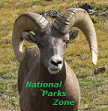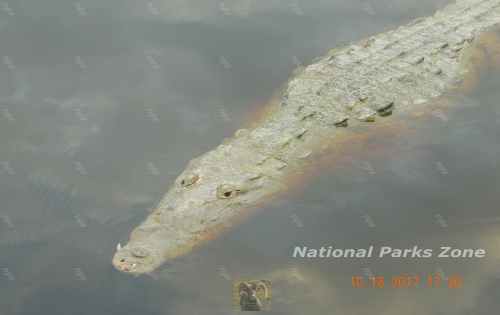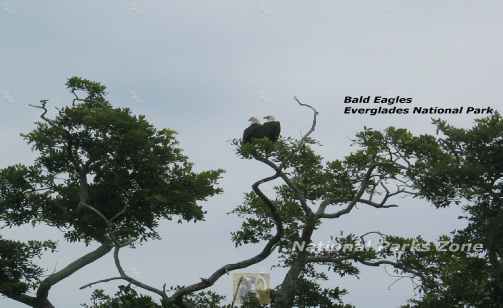Copyright © 2014-
All Rights Reserved

Updated 02/11/23 7:04 PM
Everglades National Park
Florida's Everglades is a wilderness of sawgrass, flowing water, wildlife and serenity. It is home to crocodiles, alligators, vultures, manatees and bald eagles.
Florida
2003, 2007, 2010, 2016, 2017
About The Park
The Everglades is the ‘sea of grass’ that is the overflow from Florida’s Lake Okeechobee. It is a World Heritage Site and International Biosphere Reserve and the largest tropical wilderness in the United States. It covers 1.5 million acres of wetlands. Unfortunately it is on life support due to the encroachment of farmlands and the water needs of the farms and sugar plantations in the Lake Okeechobee area.
Of the three entrances to Everglades, which are widely spaced apart and not connected in any way, my favorite way in is the Ernest F. Coe visitor center near Florida City south of Miami. This gets you to the main part of the national park and the road goes all the way out to Flamingo on Florida Bay.
If you are visiting the Miami area then driving south to the Coe visitor center is preferable because it will give you a much richer Everglades National Park experience.
One thing to note is don’t forget to bring insect repellant! The Everglades, being a tropical wetland, can be nasty with insects in the summer. Occasionally you can be swarmed by them – not a pleasant experience. It is also worth noting that the Everglades has two seasons – wet and dry. The wet season is from April to November and the dry season from November to March. The wet season, extending over Florida’s typically hot summers, is a tougher time to visit with the heat and mosquitoes.
Right off the road to Royal Palm there is another paved road that leads to an old Nike missile installation – a relic of the cold war meant to intercept missiles coming from Cuba and was opened in 1965. It was decommissioned in 1979. It is open for ranger guided tours from December to March. The last time I was there it was October and the last part of the road to the site itself was closed and there was little to see across the sawgrass where the site was located on a hilltop.
As you continue down the park road there are are a few more hammocks with boardwalks and trails that’ll take you through a tropical wilderness of mangroves, pineland, cypress and fresh water sloughs.
Flamingo
At the end of the park road, about 39 miles from the park entrance, on the shores of Florida Bay is Flamingo where there is the visitor center, boat tours, bicycle rentals and hiking trails. The road is good and pretty straight and the drive can be done in under 1.5 to 2 hours (depending on stops). Here you can see the vastness of the river of grass that is The Everglades.
The worst and most prevalent form of wildlife in the Everglades are the mosquitos. Twice when I was at Flamingo I managed to find a spot where a swarm of mosquitoes descended upon me. When that happens you make a beeline for your car and shut the door quickly. Insect repellent works to a point but some of these mosquitoes just seem impervious to it.
On the plus side I did get to see many American salt water crocodiles. I photographed a six or seven foot one that came right up to the sea wall upon which I was standing. Having this creature little more than 3 feet from me was a bit uncomfortable even with him being in the water. I backed up from the sea wall and we studied each other from a distance that I felt safe from.
You may also see bald eagles, ospreys and the notorious Black Vultures .
Driving back from flamingo at dusk I was fortunate to catch some really magnificent sunsets which the park is known for. We stopped multiple times for pictures as the light kept changing and it seemed like it just got more beautiful until the sun finally dipped below the horizon.
Shark Valley
The other part of Everglades National Park that I find interesting is Shark Valley which is off the Tamiami Trail (US 41) about 33 miles west of Miami. There is the Shark Valley Visitor Center and a tram which will take you about 7 miles out to an observation tower where you can look out over the Everglades. The tram makes a 15 mile loop. You can rent a bike and ride to the tower or walk it -
Nearby there is the Loop Road Scenic Drive that goes through a forested area and hooks back to the Tamiami Trail. The road is a hard graded road and no problem for a car provided that the road is dry.
I would recommend the Shark Valley entrance for people driving across the state on U.S. 41 because you pass it on the way to the west coast. Shark Valley is small, with little to do except take the tram, or bike, to the overlook.
Chokoloskee
There’s another visitor center, the Gulf Coast Visitor Center, near Everglades City which is not far from Naples on the West Coast. The turn-
The reason I have visited the Everglades so many times, many more than the dates listed at the top, is not an abiding love of the place. I do always enjoy going there but I just happen to have family in south Florida.
Wildlife
Salt water crocodiles can be seen at Flamingo swimming around the boat slips. West Indian manatees inhabit Florida Bay and are more likely to be see on a boat tour. Herons and egrets can often be seen along the side of the road and along the hiking trails.
On one of my trips I was fortunate enough to see a pair of bald eagles about 20 feet up in a tree. We stood below and took pictures until they decided they’d seen enough of us and flew off.
Another bit of wildlife found in South Florida which has become quite a problem in Everglades National Park is the Black Vulture. They seem to have developed an affinity for the rubber on vehicles. Windshield wipers, the rubber around Windows and sunroofs have been targeted by them and people have come back to their car and found thousands of dollars in damages. To this end the Park Service has been loaning, free of charge, tarps and bungee cords to cover your vehicle. The National Park Service website for Everglades has a picture of about a half dozen vultures perched on a car.
The endangered Florida Panther exists in small numbers in the Western part of the Everglades. Unfortunately they are probably more likely to be seen as road kill since they seem to have a penchant for crossing the roads at night.
Another animal, reptile actually, that you are unlikely to see but which is having a profound impact on the Everglades is the Burmese Python. I believe one theory as to how they got there, since they are not a native species, is that hurricane Andrew seriously damaged a pet store in that South Florida area and they escaped from it. Whatever the case they grow large and are thought to be the main reason for the sharp decline in the numbers of mammals in the park. They’ve also been known to kill and eat alligators and have even died trying to ingest them.
There are places along the Tamiami Trail on the way back to Miami (or out towards Naples or Everglades City) where you can stop and see alligators in the rivers and canals. They may be sunning themselves along the shore and, while you can walk up close to them, it is definitely not advisable. They can lunge about half of their body length and run surprisingly fast given their short stubby legs. If you find youself having to beat a hasty retreat -
Remember, in any national park, if your behavior causes an animal to change it’s behavior then you are too close.
Lodging
Other than campgrounds there is no lodging in Everglades National Park. Lodging can be found in the surrounding cities: Miami, Florida City, Homestead, Everglades City and Chokoloskee.
Hiking
Royal Palm Hammock
A miles down the main park road from the Ernest F. Coe Visitor Center is the Royal Palm hammock. (A hardwood hammock is a dense stand of broad-
For more detailed information about these hikes that follow there is link for Everglades hiking trails under Other Resources below.
Anhinga Trail and Gumbo Limbo Trail
The short Anhinga Trail (0.8 miles) and the Gumbo Limbo trail, both go through the forest, and are other good spots for wildlife viewing. I was lucky on one trip to see a mother alligator, in her ‘hole’ (a small water filled ‘nest’), with a brood of baby alligators that she was protecting. They were about 2 feet long and the mother about 8 feet. Other alligators would see the babies as tasty little morsels and mom is there to keep them away. It is 4 miles from the Ernest Coe Visitor Center.
Pa-Hay-Okee Overlook
This 800 foot trail leads to a raised observation platform and is 13 miles from the visitor center.
Mahogany Hammock
This self-
Everglades National Park Photo Gallery
Other Resources
Everglades National Park on the National Parks Service Website -
Everglades_National_Park -
Everglades Hiking Trails


Other National Parks Within a Day’s Drive
Biscayne National Park Here you can take a glass-
Dry Tortugas National Park After you take the 140-
*N*P*Z*
National Parks Zone